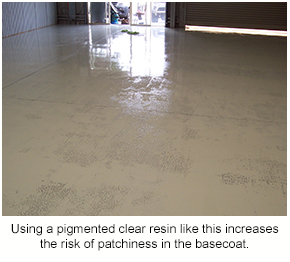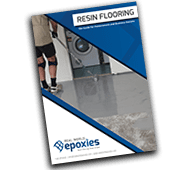Home › Advice › Know How › Knowhow
5 Questions for a Good Flake Rollcoat
Using any old basecoat under flake may seem like a good way to save a bit of cash or use up old
stock, but it can also come back to bite you.
The truth is if you want to put down consistently great-looking floors, you’ve got to use a quality epoxy rollcoat. Here are five
questions to ask when choosing the right one for flake floors.
1. Does it contain solvent/water?
With solvent-borne or water-borne basecoats, the main thing to watch out for is open time. Make sure you can roll it out and broadcast
before it flashes off, otherwise you could suffer with patchiness and bald spots (where the flake hasn’t stuck). Solventless epoxies
have an advantage here because you’ve got a bigger window to get an even film and spread the flake exactly how you want it.
2. What’s in Part B?
For a 100% solids epoxies in particular, it pays to understand what type of hardener is used. IPD-based products are
inconsistent, and I’ve heard many stories about them misbehaving. Try to find a product that has a bit more tolerance so that you don’t have
to constantly worry about humidity or temperature.
3. Is it a proper rollcoat?
While you want something that rolls out easily, the common practice of putting pigment into a clear epoxy resin isn’t ideal either.
This type of basecoat not only struggles with coverage and colour separation, it can also
be sucked up by the concrete and the flake. Look for a proper rollcoat instead – a tintable coating with a bit of “body” that blocks out
the concrete and forms a nice bed of resin for the flake to settle into.

4. Is it easy to use?
Proper rollcoats are also typically much easier to use, especially out of storage. Throwing a bit of filler and pigment into a clear
epoxy resin might be easy on the day, but what happens with split kits and leftovers? Figuring out mix ratios is confusing and prone to
error, while digging up settled powder from the bottom of the bucket is a pain in the you-know-what.
5. How much difference does pricing make?
Finally, have a think about how much money you can actually save through your choice of basecoat. For example, putting down a 250-micron
basecoat on a 40m2 garage will take 10 litres. Even if you managed to save $5 per litre buying a cheaper product, you’d only
claw back $50 on a job worth somewhere around $2000. Is $50 worth the trouble?
- Ezypoxy Rollcoat - Tintable Epoxy Rollcoat
- Epoxy Flooring How To Videos
- Epoxy Flooring Short Courses
- Garage Granite Installation Course
- Bronze Card Course
- Silver Card Course
_400x135a.png)
